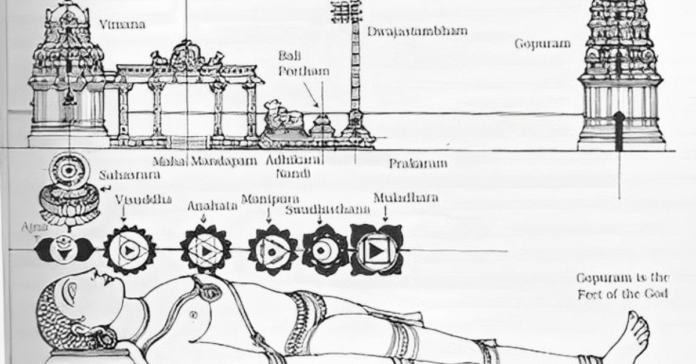Introduction: Where Spirituality Meets Science
For centuries, Hindu temples have been more than just places of worship—they are living embodiments of cosmic energy, meticulously designed to reflect the human body and its spiritual essence. every part of a temple corresponds to a human anatomical and energetic system, from the feet (Gopuram) to the crown (Vimana).
But why? What is the deeper meaning behind this sacred geometry? And how does this ancient wisdom influence modern spirituality?
In this article, we explore:
✔ The hidden symbolism of temple structures (Vimana, Garbhagruha, Gopuram, etc.)
✔ How temple layouts align with the human chakra system
✔ Scientific and philosophical perspectives on this connection
✔ Real-world examples of temples designed like the human body
1. Temple as the Human Body: A Divine Blueprint
The Vimana (Head) – Crown of Divine Consciousness
- Symbolism: Represents the Sahasrara Chakra (crown chakra), the pinnacle of spiritual awakening.
- Architectural Role: The tallest tower, often adorned with intricate carvings of deities, signifying divine wisdom.
- Example: The Brihadeeswarar Temple in Thanjavur has a massive Vimana, symbolizing Shiva’s cosmic presence.
The Maha Mandapam (Chest) – Heart of the Temple
- Symbolism: Corresponds to the Anahata Chakra (heart chakra), the center of love and devotion.
- Architectural Role: A large hall where devotees gather, representing unity and emotional connection.
- Example: Meenakshi Temple’s thousand-pillared hall embodies this energy.
The Garbhagriha (Heart) – Sanctum of the Soul
- Symbolism: The innermost chamber, where the deity resides, mirrors the human heart (or Hridaya in yoga).
- Architectural Role: A dark, womb-like space symbolizing the soul’s journey inward.
- Example: Tirupati’s Garbhagriha is designed to amplify spiritual vibrations.
The Gopuram (Feet) – Foundation of Existence
- Symbolism: Represents the Muladhara Chakra (root chakra), grounding energy.
- Architectural Role: The towering gateway marks the transition from the material world to the divine.
- Example: Madurai’s 14-tiered Gopuram signifies ascending consciousness.
2. Chakras & Temple Architecture: Energy Flow in Stone
The temple’s design isn’t random—it’s a 3D map of the human energy system (Kundalini Yoga).
| Temple Part | Human Chakra | Spiritual Significance |
|---|---|---|
| Vimana | Sahasrara (Crown) | Enlightenment, divine wisdom |
| Maha Mandapam | Anahata (Heart) | Love, compassion, devotion |
| Garbhagriha | Hridaya (Soul) | Inner sanctum, divine presence |
| Ardha Mandapam | Vishuddha (Throat) | Communication, sacred chants |
| Gopuram | Muladhara (Root) | Stability, earthly connection |
Scientific Perspective: Resonance & Sacred Geometry
- Studies in architectural bio-geometry suggest that temple designs create harmonic resonance, enhancing meditation.
- The Golden Ratio (1.618) is often found in temple dimensions, mirroring proportions in human DNA.
12 Most Powerful Temples in South India for Miracles & Blessings
3. Real-World Temples Designed Like the Human Body
A. Brihadeeswarar Temple (Thanjavur)
- Vimana = Crown Chakra (216 ft tall, representing cosmic ascent).
- Garbhagriha = Heart Chakra (housed in a perfectly aligned granite chamber).
B. Konark Sun Temple (Odisha)
- Designed as a chariot with 24 wheels, symbolizing the 24 vertebrae of the spine (Kundalini energy).
C. Rameshwaram Temple (Tamil Nadu)
- Long corridors = Nadis (energy channels) in yoga.
4. Why Does This Matter Today?
✔ Healing Spaces: Temples act as energy amplifiers, aiding meditation and stress relief.
✔ Architectural Wisdom: Modern wellness centers now use Vastu Shastra (temple science) for harmony.
✔ Spiritual Tourism: More seekers visit temples not just for prayers, but for energetic rejuvenation.
Conclusion: The Temple Within
The next time you enter a temple, remember—you’re not just walking into a building; you’re stepping into a mirror of your own soul. From the grounding Gopuram to the soaring Vimana, every stone whispers an ancient truth: the divine is not outside of us—it is us.
Have you felt this energy in a temple? Share your experience below!











